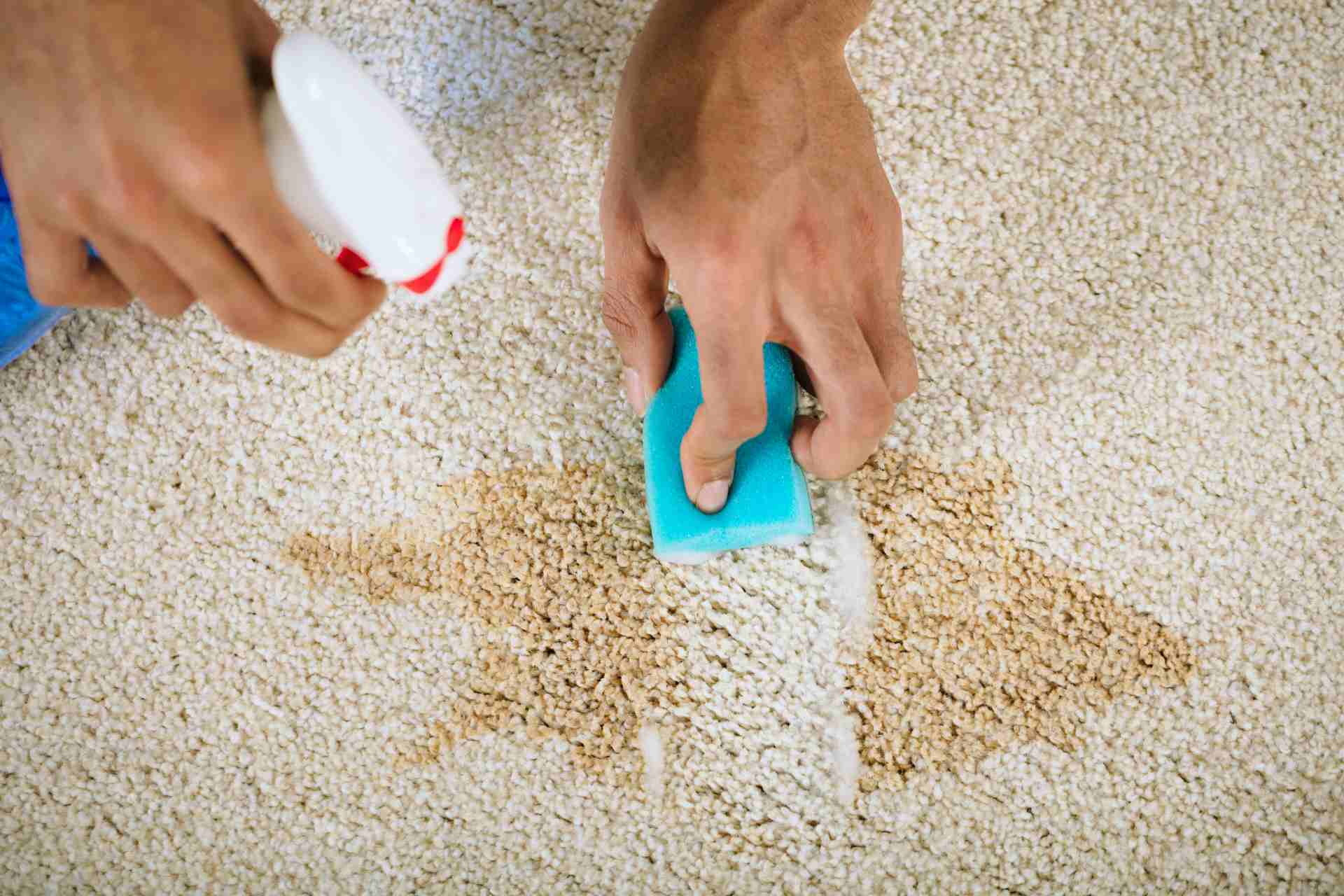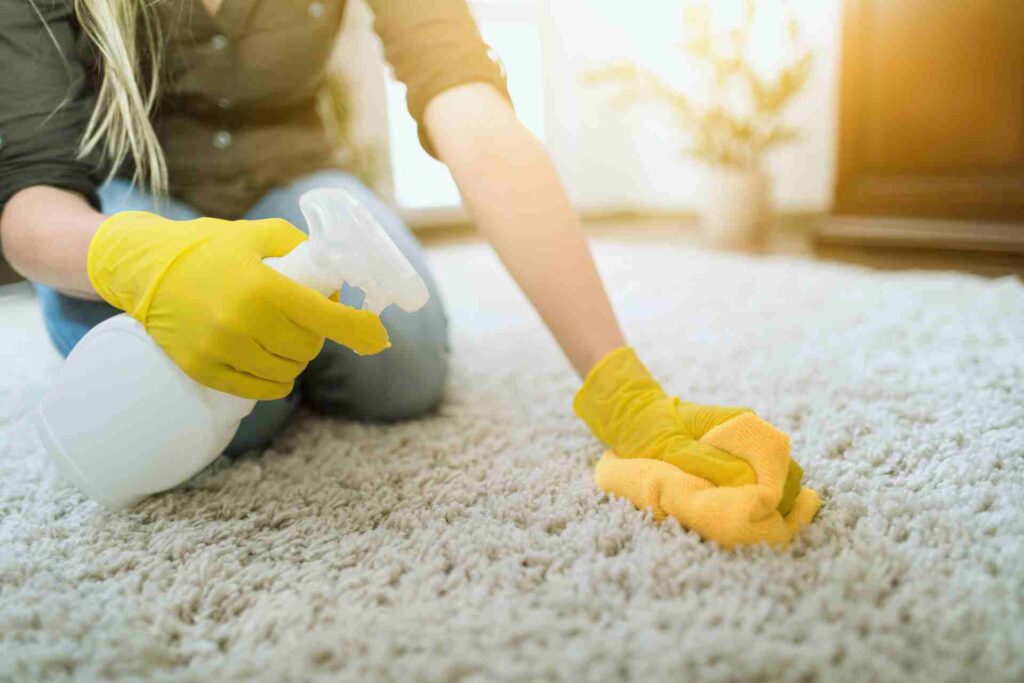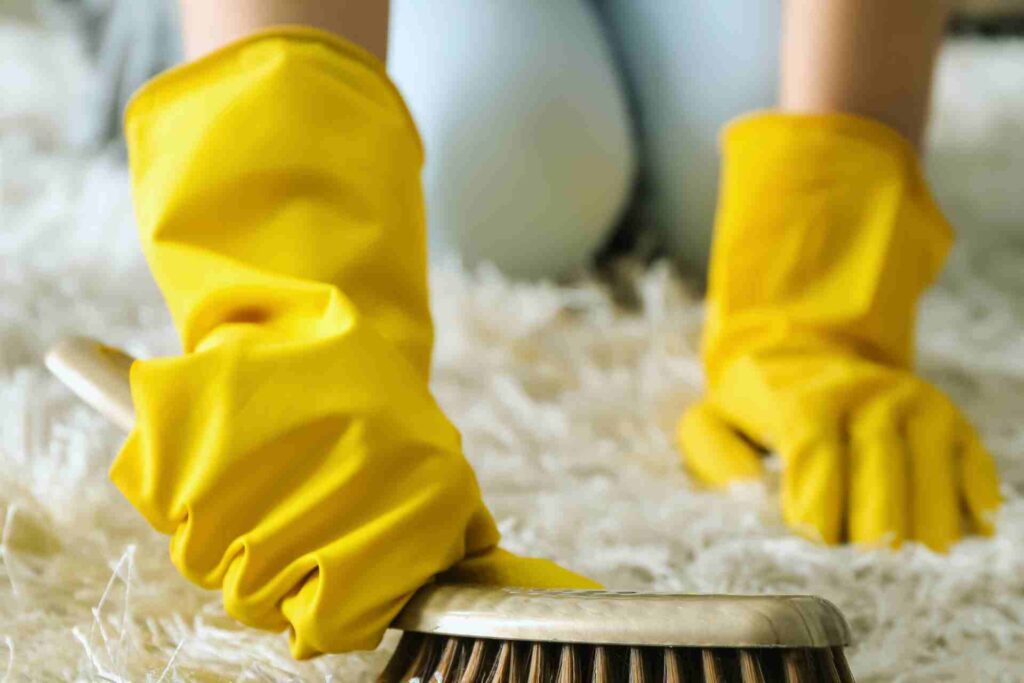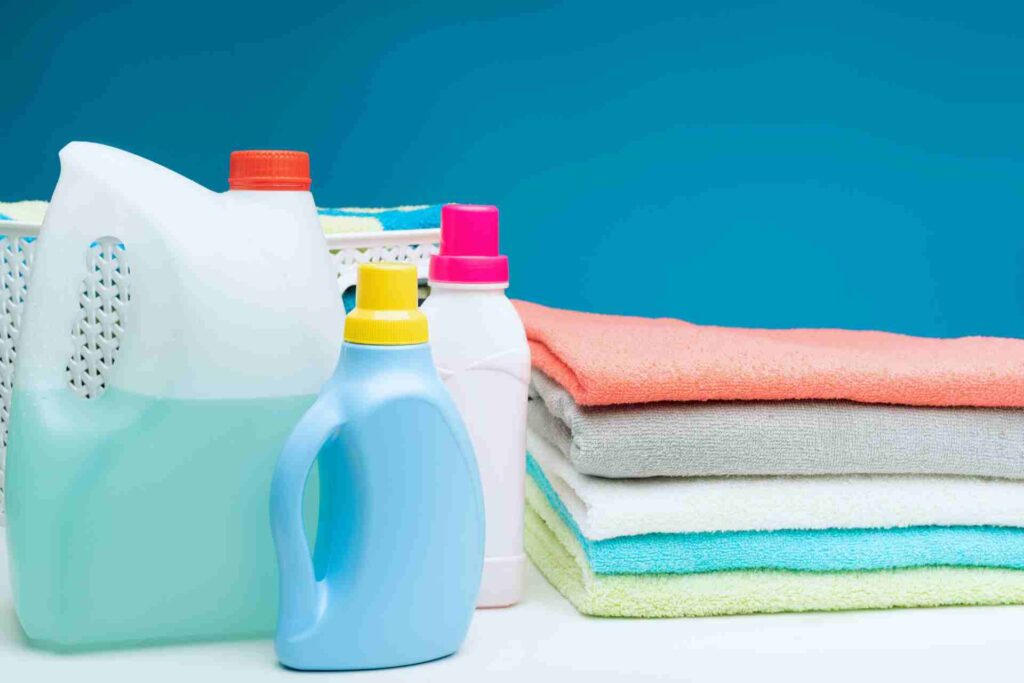
Bleach on Carpet: Risks, Steps, and Safer Alternatives
Bleach can be a powerful ally in the fight against tough stains, but when it comes to carpets, it requires careful handling. While bleach can effectively remove discoloration, it may also cause irreparable harm to many carpet fibers.
When is it safe to use bleach on carpets? Generally, bleach is not recommended for natural fibers like wool or silk, as it can lead to:
- Discoloration
- Fiber damage
- Patches that won’t be fixable
However, it’s sometimes suitable for synthetic fibers, yet extreme caution is advised.
Consider safer alternatives like vinegar or baking soda, which can help keep your carpets looking fresh and clean without the risk.
Remember, professional carpet cleaning services are equipped to handle a variety of fabrics, ensuring your carpets receive the delicate care they need. Always test a small, hidden area first if you decide to go the DIY route.
When You Should (or Shouldn’t) Use Bleach on Carpet
Situations Where Bleach Might Be Used
Sometimes, bleach can tackle those persistent stains that just won’t quit. Those stubborn spots from mildew or mold? Bleach can step in and zap them away.
It’s also a handy sanitizer for high-traffic areas that attract unwelcome bacteria or allergens.
However, remember the following:
- Bleach is best reserved for white or light-colored carpets.
- Darker carpets and bleach? Not a good mix.
Situations Where Bleach Should Be Avoided

When you’ve got a colored or patterned carpet, bleach is your worst enemy—it might strip away those vibrant shades and designs. For those luxurious, delicate fibers like wool, steer clear! Bleach can cause fibers to degrade and weaken, leaving your carpet looking worse for wear.
Additionally, don’t even think about using bleach in a **poorly ventilated area**—those fumes can be harsh. Always ensure proper airflow to keep things safe and breathable.
With these points in mind, approach bleach with caution and wisdom. Here’s a quick reminder:
- Avoid bleach on colored or patterned carpets
- Skip it for wool and delicate fibers
- Ventilate the area properly if using any harsh chemicals
At A Personal Touch Cleaning & Restoration, we’re here to provide expertise and care for all your carpet cleaning needs. Rest assured, we’ve got the right solutions and the know-how to keep your carpets beautiful without risky shortcuts.
Step-by-Step Guide to Using Bleach on Carpet
Step 1: Test in an Inconspicuous Area
Why’s testing so essential? It safeguards your entire carpet from unexpected mishaps.
By trying a hidden corner first, you can spot any potential issues, such as:
- Color fading
- Fiber weakening
It’s a small step with a big impact, ensuring that when you go big, you do it safely.
Step 2: Dilute the Bleach
Recommended dilution ratio: Mix one part bleach with five parts water to reduce its strength. This step is imperative to mitigate the harsh effects bleach can have on carpet fibers.
Important tips:
- Never use undiluted bleach on carpet, as it can lead to severe discoloration and degradation of the material.
- Dilute bleach properly to minimize the risk of damaging your carpet.
- Effectively tackle stubborn stains while preserving your carpet’s integrity.
Step 3: Apply the Bleach Solution
Now that you’re all set with the right dilution, it’s time to apply. Use a spray bottle to evenly mist the stained spot—just a light touch, no need to drench the area. We don’t want those fibers getting weaker.

Once sprayed, gently blot with a clean, absorbent cloth. Letting it sit for a minute or two helps those stubborn stains break down, ensuring a cleaner carpet without the hassle.
Step 4: Rinse Thoroughly
Rinsing might seem like an extra step, but trust us—it’s a game changer! Any residue from the bleach left unattended may lead to damage over time, so give it a good rinse with cold water.
This action neutralizes the bleach, stopping it from causing more harm. Here’s what to do:
- Rinse the area thoroughly with cold water.
- Blot the area dry using clean towels.
This helps remove excess moisture, keeping your carpet fresh and intact.
Step 5: Allow the Carpet to Dry
Your patience here will pay off. Proper drying is key to preventing any mishaps.
To ensure your carpet dries thoroughly and evenly, consider the following tips:
- Use fans or simply open those windows to encourage air flow.
- Avoid walking on the carpet until it’s completely dry.
Risks and Potential Problems When Using Bleach on Carpet
Risks of Overuse or Improper Application
Using bleach can feel like a fast-track solution to pesky stains, but it comes with its share of risks. Overdoing it can lead to severe consequences for your carpet’s appearance and longevity.
- Color loss and patchy discoloration: You might think that a little more bleach could zap those stains away even faster, but be wary. Overuse can result in uneven bleaching, even on light carpets. What does this look like? You may end up with visible white spots or faded patches scattered across your floor.
- Fiber weakening and damage: Long-term exposure to bleach doesn’t just affect color—it can also compromise the integrity of your carpet fibers. They may become brittle and prone to breakage, which can be more trouble than the stains themselves.
Here’s a tip: apply bleach only to stubborn spots, not entire areas, to minimize damage.
Health Concerns and Safety Precautions
While bleach is an effective cleaner, it can pose health risks if not handled properly.
- Ventilation needs: Always ensure you’re working in a well-ventilated space. Bleach produces harmful fumes that should not be inhaled, so open windows or use fans to keep the air moving.
- Skin and eye protection: Protect yourself from splashes. Wear gloves and protective eyewear to safeguard against irritation. Direct contact with bleach can be unpleasant, so take these precautions seriously.

At A Personal Touch Cleaning & Restoration, we’re dedicated to ensuring your safety and satisfaction. Reach out to us for a free estimate and let our expertise take on even the toughest stains with care and precision!
Safer Alternatives to Bleach for Carpet Cleaning
Oxygen-Based Cleaners
Looking for safer options? Oxygen-based cleaners might be just what the doctor ordered. Unlike their harsh chlorine cousin, oxygen bleach is color-safe and kinder on those precious fibers.
This makes it a prime candidate for refreshing your carpet without the risk of unwanted color change. Here are some benefits of using oxygen-based cleaners:
- Color-safe: Protects your carpets from fading.
- Gentle on fibers: Keeps your carpets looking new.
- Highly recommended: Many carpet cleaners advocate for these alternatives.
With these gentle giants, you can dodge any color-fading dilemmas!
Vinegar and Baking Soda Mixture
How about a natural solution that doesn’t break the bank or your back? Say hello to the dynamic duo: vinegar and baking soda.
This combo is not only effective at lifting stubborn stains but also non-toxic, making it a go-to for eco-conscious homeowners. Here’s why this mix is a great choice:
- Effective for tackling tough stains
- Non-toxic, safe for your home
- Works on bright, colorful carpets and classic light ones
This combination ensures your carpets stay fresh and vibrant with ease!
Understanding Bleach and Its Effects on Carpet
What is Bleach?

Bleach—it’s that wonder-working cleaner many swear by for its whitening and disinfecting prowess. At its core, it’s made up of sodium hypochlorite, a chemical powerhouse designed to break down stubborn stains.
You’ll often find it used in:
- Laundry rooms
- On hard surfaces, where its bleaching abilities shine.
How Bleach Affects Carpet Fibers
Bleach doesn’t just normalize—it reorganizes. When it comes to carpet colors, bleach tackles them head-on by dismantling the dye molecules that give your carpet its richly colored appearance. What’s the result? You might see your carpet permanently lightened or noticeably discolored.
Keep in mind that carpets dyed with natural fibers might be even more at risk, waving a white flag more readily than their synthetic cousins. Specifically:
- Wool and natural fibers: Stand on the frontline of bleach’s effects, easily falling victim to damage.
- Synthetic fibers: Materials like nylon and polyester may hold their ground a bit better, but they’re not immune to damage. You might still notice unwelcome discoloration.
So, while bleach can be a trusty friend in many cleaning endeavors, with carpet, it’s a relationship that requires a little extra caution and care.
Final Thoughts on Using Bleach on Carpet
Bleach can be your ace in the hole for those rare, stubborn stains, but it’s not without its pitfalls. Sure, it’s powerful, but that power can turn destructive if not handled with care. Damage to carpet fibers and color—those are unwelcome guests in any home.
So, what’s the bottom line? Use bleach sparingly and only when you’re sure it’s the best option.
Feeling uncertain? Don’t fret! Here are some safer alternatives:
- Oxygen-based cleaners: Gentle yet effective for most stains.
- Professional carpet cleaning services: Perfect for tough messes, providing precision and care.
Trustworthy pros bring both expertise and a light touch, ensuring your carpets remain vibrant and damage-free.
Unsure about using bleach on your carpet? Contact us today for expert advice and safer solutions! We’re here to help protect your carpets and ease your mind.
